Kyrgyzstan
Coordinates: 41°N 75°E / 41°N 75°E / 41; 75
Kyrgyz Republic Кыргыз Республикасы (Kyrgyz) Киргизская Республика (Russian) | |
|---|---|
 Flag  Emblem | |
Anthem: Кыргыз Республикасынын Мамлекеттик Гимни Kırğız Respublikasının Mamlekettik Gimni National Anthem of the Kyrgyz Republic | |
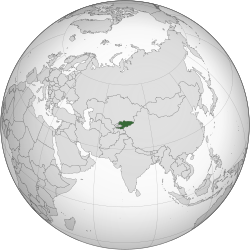 Location of Kyrgyzstan (green) | |
| Capital and largest city | Bishkek 42°52′N 74°36′E / 42.867°N 74.600°E / 42.867; 74.600 |
Official languages[1] |
|
Ethnic groups (2018[3]) |
|
| Religion | Islam, Christianity (Russian Orthodoxy), Buddhism, Bahai, Judaism |
| Demonym(s) | Kyrgyzstani;[4] Kyrgyz |
| Government | Unitary parliamentary republic |
• President | Sooronbay Jeenbekov |
• Prime Minister | Muhammetkaliy Abulgaziyev |
| Legislature | Joğorqu Keñeş |
Independence .mw-parser-output .noboldfont-weight:normal from the Soviet Union | |
• Kara-Kirghiz AO | 14 October 1924 |
• Kirghiz SSR | 5 December 1936 |
• Independence declared | 31 August 1991 |
• CIS full membership | 21 December 1991 |
• Recognized | 25 December 1991 |
• Admitted to the United Nations | 2 March 1992 |
• Current constitution | 27 June 2010 |
| Area | |
• Total | 199,951 km2 (77,202 sq mi) (85th) |
• Water (%) | 3.6 |
| Population | |
• 2016 estimate | 6,019,480[2] (110th) |
• 2009 census | 5,362,800 |
• Density | 27.4/km2 (71.0/sq mi) (176th) |
GDP (PPP) | 2018 estimate |
• Total | $24.356 billion[5] (139th) |
• Per capita | $3,812[5] (147th) |
GDP (nominal) | 2018 estimate |
• Total | $8.013 billion[5] (145th) |
• Per capita | $1,254[5] (157th) |
Gini (2016) | 26.8[6] low |
HDI (2016) | medium · 120th |
| Currency | Som (KGS) |
| Time zone | UTC+6 (KGT) |
| Driving side | right |
| Calling code | +996 |
| ISO 3166 code | KG |
| Internet TLD | .kg |
Kyrgyzstan (/ˌkɜːrɡɪˈstɑːn/ KUR-gih-STAHN;[8]Kyrgyz: Кыргызстан Kırğızstan (Kyrgyz pronunciation: [qɯrʁɯsˈstɑn]); Russian: Киргизия [kʲɪrˈɡʲizʲɪjə] or Кыргызстан [kɨrɡɨˈstan]), officially the Kyrgyz Republic (Kyrgyz: Кыргыз Республикасы, translit. Kırğız Respublikası; Russian: Киргизская Республика, tr. Kirgizskaya Respublika), and also known as Kirghizia,[9] is a country in Central Asia.[10] Kyrgyzstan is a landlocked country with mountainous terrain. It is bordered by Kazakhstan to the north, Uzbekistan to the west and southwest, Tajikistan to the southwest and China to the east. Its capital and largest city is Bishkek.
Kyrgyzstan's recorded history spans over 2,000 years, encompassing a variety of cultures and empires. Although geographically isolated by its highly mountainous terrain, which has helped preserve its ancient culture, Kyrgyzstan has been at the crossroads of several great civilizations as part of the Silk Road and other commercial and cultural routes. Though long inhabited by a succession of independent tribes and clans, Kyrgyzstan has periodically fallen under foreign domination and attained sovereignty as a nation-state only after the breakup of the Soviet Union in 1991.
Since independence, the sovereign state has officially been a unitary parliamentary republic, although it continues to endure ethnic conflicts,[11][12] revolts,[13] economic troubles,[14][15] transitional governments[16] and political conflict.[17] Kyrgyzstan is a member of the Commonwealth of Independent States, the Eurasian Economic Union, the Collective Security Treaty Organization, the Shanghai Cooperation Organisation, the Organisation of Islamic Cooperation, the Turkic Council, the Türksoy community and the United Nations.
Ethnic Kyrgyz make up the majority of the country's 6 million people, followed by significant minorities of Uzbeks and Russians. Kyrgyz is closely related to other Turkic languages, although Russian remains widely spoken and is an official language, a legacy of a century of Russification. The majority of the population are non-denominational Muslims.[18] In addition to its Turkic origins, Kyrgyz culture bears elements of Persian, Mongolian, and Russian influence.
Contents
1 Etymology
2 History
2.1 Antiquity
2.2 Russian colonial era
2.3 Soviet Kyrgyzstan
2.4 Independence
3 Politics
3.1 Human rights
3.2 Military
3.3 Administrative divisions
4 Geography
4.1 Climate
4.2 Enclaves and exclaves
5 Climate Action
5.1 Climate change contributions
5.1.1 Greenhouse gases
5.2 Climate change impacts
5.2.1 Agriculture
5.2.2 Energy sector
5.2.3 Forestry
5.2.4 Natural disasters
5.3 Climate action strategies and plans
5.3.1 Glacier monitoring
5.3.2 Hydro power rehabilitation projects
5.3.3 Emergency disaster risk management
6 Economy
7 Demographics
7.1 Ethnic groups
7.2 Languages
7.3 Population centres
7.4 Religion
8 Culture
8.1 Traditions
8.2 Flag
8.3 Horse riding
8.4 Public holidays
8.5 Tourism
8.6 Sports
8.7 Science and technology
9 Education
10 Transport
10.1 Airports
10.2 Banned airline status
10.3 Railways
10.3.1 Rail links with adjacent countries
10.4 Highways
10.5 Waterways
10.6 Ports and harbours
11 See also
12 References
13 Further reading
14 External links
Etymology
"Kyrgyz" is believed to have been derived from the Turkic word for "forty", in reference to the forty clans of Manas, a legendary hero who united forty regional clans against the Uyghurs. Literally, Kyrgyz means We are forty. At the time, in the early 9th century AD, the Uyghurs dominated much of Central Asia (including Kyrgyzstan), Mongolia, and parts of Russia and China.[19]
The 40-ray sun on the flag of Kyrgyzstan is a reference to those same forty tribes and the graphical element in the sun's center depicts the wooden crown, called tunduk, of a yurt—a portable dwelling traditionally used by nomads in the steppes of Central Asia.
In terms of naming conventions, the country's official name is "Kyrgyz Republic" whenever it is used in some international arenas and foreign relations.[20][21] However, in the English-speaking world, the spelling Kyrgyzstan is commonly used while its former name Kirghizia is rarely used as such.[9]
History
Antiquity
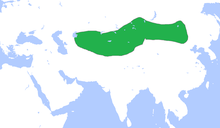
The Turkic Khaganate.
According to David C. King, Scythians were early settlers in present-day Kyrgyzstan.[22]
The Kyrgyz state reached its greatest expansion after defeating the Uyghur Khaganate in 840 A.D.[23] From the 10th century the Kyrgyz migrated as far as the Tian Shan range and maintained their dominance over this territory for about 200 years.
In the twelfth century the Kyrgyz dominion had shrunk to the Altay Range and Sayan Mountains as a result of the Mongol expansion. With the rise of the Mongol Empire in the thirteenth century, the Kyrgyz migrated south. The Kyrgyz peacefully became a part of the Mongol Empire in 1207.
The descent of the Kyrgyz from the indigenous Siberian population, on the other hand, is confirmed by recent genetic studies.[24] Because of the processes of migration, conquest, intermarriage, and assimilation, many of the Kyrgyz peoples who now inhabit Central and Southwest Asia are of mixed origins, often stemming from fragments of many different tribes, though they now speak closely related languages.[25][26]
Issyk Kul Lake was a stopover on the Silk Road, a land route for traders, merchants and other travelers from the Far East to Europe.
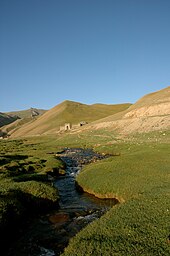
Silk road caravansarai utilized during the Islamic Golden Age
Kyrgyz tribes were overrun in the 17th century by the Mongols, in the mid-18th century by the Manchurian Qing Dynasty, and in the early 19th century by the Uzbek Khanate of Kokand.[27]
Russian colonial era
In the late nineteenth century, the eastern part of what is today Kyrgyzstan, mainly the Issyk-Kul Region, was ceded to the Russian Empire by Qing China through the Treaty of Tarbagatai.[28] The territory, then known in Russian as "Kirghizia", was formally incorporated into the Empire in 1876. The Russian takeover was met with numerous revolts, and many of the Kyrgyz opted to relocate to the Pamir Mountains and Afghanistan.
In addition, the suppression of the 1916 rebellion against Russian rule in Central Asia caused many Kyrgyz later to migrate to China.[29] Since many ethnic groups in the region were (and still are) split between neighboring states at a time when borders were more porous and less regulated, it was common to move back and forth over the mountains, depending on where life was perceived as better; this might mean better rains for pasture or better government during oppression.
Soviet Kyrgyzstan
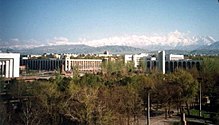
Bishkek
Soviet power was initially established in the region in 1919, and the Kara-Kyrgyz Autonomous Oblast was created within the Russian SFSR (the phrase Kara-Kirghiz was used until the mid-1920s by the Russians to distinguish them from the Kazakhs, who were also referred to as Kirghiz). On 5 December 1936, the Kirghiz Soviet Socialist Republic was established as a constituent Union Republic of the Soviet Union.
During the 1920s, Kyrgyzstan developed considerably in cultural, educational and social life. Literacy was greatly improved, and a standard literary language was introduced by imposing Russian on the populace. Economic and social development also was notable. Many aspects of the Kyrgyz national culture were retained despite the suppression of nationalist activity under Joseph Stalin.
The early years of glasnost had little effect on the political climate in Kyrgyzstan. However, the Republic's press was permitted to adopt a more liberal stance and to establish a new publication, Literaturny Kirghizstan, by the Union of Writers. Unofficial political groups were forbidden, but several groups that emerged in 1989 to deal with the acute housing crisis were permitted to function.
According to the last Soviet census in 1989, ethnic Kyrgyz made up only 22% of the residents of the northern city of Frunze (now Bishkek), while more than 60% were Russians, Ukrainians, and people from other Slavic nations. Nearly 10% of the capital's population were Jewish (a rather unique fact, for almost any place in the Soviet Union, except the Jewish Autonomous Republic).
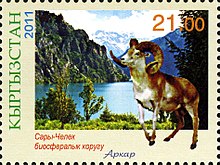
Marco Polo sheep on a Kyrgyzstan stamp
In June 1990, ethnic tensions between Uzbeks and Kyrgyz surfaced in the Osh Oblast (southern Kyrgyzstan), where Uzbeks form a minority of the population.[30] Attempts to appropriate Uzbek collective farms for housing development triggered the Osh Riots. A state of emergency and curfew were introduced[31] and Askar Akayev, the youngest of five sons born into a family of collective farm workers (in northern Kyrgyzstan), was elected president in October of that same year.

The statue of Vladimir Lenin in Bishkek
By then, the Kyrgyzstan Democratic Movement (KDM) had developed into a significant political force with support in Parliament. On 15 December 1990, the Supreme Soviet voted to change the republic's name to the Republic of Kyrgyzstan. The following January, Akayev introduced new government structures and appointed a new cabinet composed mainly of younger, reform-oriented politicians. In February 1991, the name of the capital, Frunze, was changed back to its pre-revolutionary name of Bishkek.
Despite these political moves toward independence, economic realities seemed to work against secession from the Soviet Union. In a referendum on the preservation of the Soviet Union in March 1991, 88.7% of the voters approved the proposal to retain the Soviet Union as a "renewed federation". Nevertheless, secessionist forces pushed Kyrgyzstan's independence through in August of that same year.
On 19 August 1991, when the State Emergency Committee assumed power in Moscow, there was an attempt to depose Akayev in Kyrgyzstan. After the coup collapsed the following week, Akayev and Vice President German Kuznetsov announced their resignations from the Communist Party of the Soviet Union (CPSU), and the entire bureau and secretariat resigned. This was followed by the Supreme Soviet vote declaring independence from the Soviet Union on 31 August 1991 as the Republic of Kyrgyzstan.
Independence
This article or section appears to be slanted towards recent events. (September 2012) (Learn how and when to remove this template message) |
In October 1991, Akayev ran unopposed and was elected president of the new independent Republic by direct ballot, receiving 95 percent of the votes cast. Together with the representatives of seven other Republics that same month, he signed the Treaty of the New Economic Community. Finally, on 21 December 1991, Kyrgyzstan joined with the other four Central Asian Republics to formally enter the new Commonwealth of Independent States. Kyrgyzstan gained full independence a few days later on 25 December 1991. The following day, on 26 December 1991, the Soviet Union ceased to exist. In 1992, Kyrgyzstan joined the United Nations and the Organization for Security and Co-operation in Europe (OSCE). On 5 May 1993, the official name changed from the Republic of Kyrgyzstan to the Kyrgyz Republic.
In 2005, a popular uprising known as the "Tulip Revolution", took place after the parliamentary elections in March 2005, forced President Askar Akayev's resignation on 4 April 2005. Opposition leaders formed a coalition, and a new government was formed under President Kurmanbek Bakiyev and Prime Minister Feliks Kulov. The nation's capital was looted during the protests.
Political stability appeared to be elusive, however, as various groups and factions allegedly linked to organized crime jockeyed for power. Three of the 75 members of Parliament elected in March 2005 were assassinated, and another member was assassinated on 10 May 2006 shortly after winning his murdered brother's seat in a by-election. All four are reputed to have been directly involved in major illegal business ventures.[according to whom?]
On 6 April 2010, civil unrest broke out in the town of Talas after a demonstration against government corruption and increased living expenses. The protests became violent, spreading to Bishkek by the following day. Protesters attacked President Bakiyev's offices, as well as state-run radio and television stations. There were conflicting reports that Interior Minister Moldomusa Kongatiyev had been beaten. On 7 April 2010, President Bakiyev imposed a state of emergency. Police and special services arrested many opposition leaders. In response, protesters took control of the internal security headquarters (former KGB headquarters) and a state television channel in the capital, Bishkek.[citation needed] Reports by Kyrgyzstan government officials indicated that at least 75 people were killed and 458 hospitalized in bloody clashes with police in the capital.[32] Reports say that at least 80 people died as a result of clashes with police. A transition government, led by former foreign minister Roza Otunbayeva, by 8 April 2010 had taken control of state media and government facilities in the capital, but Bakiyev had not resigned from office.[33][34]
President Bakiyev returned to his home in Jalal-Abad and stated his terms of resignation at a press conference on 13 April 2010.[35] On 15 April 2010, Bakiyev left the country and flew to neighboring Kazakhstan, along with his wife and two children. The country's provisional leaders announced that Bakiyev signed a formal letter of resignation prior to his departure.[36]
Prime Minister Daniar Usenov accused Russia of supporting the protests; this accusation was denied by Russian Prime Minister, Vladimir Putin. Opposition members also called for the closing of the US-controlled Manas Air Base.[37] Russia's President Dmitry Medvedev ordered measures to ensure the safety of Russian nationals and tighten security around Russian sites in Kyrgyzstan to protect them against possible attacks.
The 2010 South Kyrgyzstan ethnic clashes occurred between the two main ethnic groups—the Uzbeks and Kyrgyz—in Osh, the second largest city in the country, on 11 June 2010. The clashes incited fears that the country could be heading towards a civil war.[38][39]

Nomads in Kyrgyzstan
Finding it difficult to control the situation, Otunbayeva, the interim leader, sent a letter to the Russian president, Dimitry Medvedev, asking him to send Russian troops to help the country control the situation. Medvedev's Press Attaché, Natalya Timakova, said in a reply to the letter, "It is an internal conflict and for now Russia does not see the conditions for taking part in its resolution". The clashes caused a shortage of food and other essential commodities with more than 200 killed and 1,685 people hurt, as of 12 June 2010[update]. The Russian government, however, said it would be sending humanitarian aid to the troubled nation.[40]
According to local sources, there was a clash between two local gangs and it did not take long for the violence to spread to the rest of the city. There were also reports that the armed forces supported ethnic Kyrgyz gangs entering the city, but the government denied the allegations.[40]
The riots spread to neighboring areas, and the government declared a state of emergency in the entire southern Jalal-Abad region. To control the situation, the interim government gave special shoot-to-kill powers to the security forces. The Russian government decided to send a battalion to the country to protect Russian facilities.[41]

Kyrgyz family in the village of Sary-Mogol, Osh Region
Otunbayeva accused the family of Bakiyev of "instigating the riots".[42] AFP reported "a veil of smoke covering the whole city". Authorities in neighboring Uzbekistan said at least 30,000 Uzbeks had crossed the border to escape the riots.[41] Osh became relatively calm on 14 June 2010, but Jalal-Abad witnessed sporadic incidents of arson. The entire region was still under a state of emergency as Uzbeks were reluctant to leave their houses for fear of attacks by the mobs. The United Nations decided to send an envoy to assess the situation.[43]

Kyrgyzstan's second largest city, Osh, in 2018
Temir Sariyev, deputy chief of the interim government, said there were local clashes and that it was not possible [for the government] to fully control the situation. He added that there were not sufficient security forces to contain the violence. Media agencies reported on 14 June 2010 that the Russian government was considering a request by the Kyrgyz government. An emergency meeting of Collective Security Treaty Organisation (CSTO) was held on the same day (14 June) to discuss the role it could play in helping to end the violence.
Ethnic violence waned, according to the Kyrgyz government, by 15 June 2010 and Kyrgyz president Roza Otunbayeva held a news conference that day and declared that there was no need for Russia to send in troops to quell the violence. There were at least 170 people left dead by 15 June 2010 but Pascale Meige Wagner of the International Committee of the Red Cross said the [official] death toll was an underestimate. The UN High Commissioner told reporters in Geneva that evidence suggested that the violence seemed to have been staged up.
Ethnic Uzbeks threatened to blow up an oil depot in Osh if they failed to get guarantees of protection. The United Nations said it believed that the attacks were "orchestrated, targeted and well-planned". Kyrgyz officials told the media that a person suspected to be behind the violence in Jalal-Abad had been detained.[44]
On 2 August 2010, a Kyrgyz government commission began investigating the causes of the clashes. Members of the National Commission, led by former parliament speaker Abdygany Erkebaev, met with people from the predominantly ethnic Uzbek villages of Mady, Shark, and Kyzyl-Kyshtak in the Kara-Suu district of Osh Oblast. This National Commission, including representatives of many ethnic groups, was established by a presidential decree.
President Roza Otunbayeva also said in August 2010 that an international commission would also be formed to investigate the clashes.[45] The international commission conducted an extensive investigation and prepared a report – The Independent international commission of inquiry into the events in southern Kyrgyzstan in June 2010 (KIC) [1]. It stated that "The Provisional Government, which had assumed power two months before the events, either failed to recognize or underestimated the deterioration in inter-ethnic relations in southern Kyrgyzstan". The KIC concluded that the "Provisional Government had the responsibility to ensure that the security forces were adequately trained and appropriately equipped to deal with situations of civil unrest" but unable to take necessary measures.
Other reports contain a different account. A report, released in January 2011, concluded that the events in southern Kyrgyzstan constituted a “planned, large-scale provocation, oriented towards the splitting of Kyrgyzstan and disrupting the unity of its people.” Responsibility for this provocation was seen as lying with “nationalistically-minded leaders of the Uzbek community”.
In the aftermath of the turmoil, on 5 August 2010, Kyrgyz forces arrested party leader Urmat Baryktabasov on suspicion of plotting an overthrow of the government, after troops allegedly fired blank rounds at a crowd trying to join mass demonstrations near the Parliament in the capital Bishkek. Acting President Roza Otunbayeva said security forces seized firearms and grenades from him and 26 supporters.[46]
Politics
@media all and (max-width:720px).mw-parser-output .tmulti>.thumbinnerwidth:100%!important;max-width:none!important.mw-parser-output .tmulti .tsinglefloat:none!important;max-width:none!important;width:100%!important;text-align:center

Sooronbay Jeenbekov, President, in office since 2017.

Mukhammedkalyi Abylgaziev, Prime Minister, in office since 2018.
The 1993 constitution defines the form of government as a democratic unicameral republic. The executive branch includes a Supreme Chancellor and Vice Chair. The parliament currently is unicameral. The judicial branch comprises a Supreme Court, local courts and a Chief Prosecutor.

President Askar Akayev (1990–2005) with U.S. President George W. Bush, 22 September 2002
In March 2002, in the southern district of Aksy, five people protesting the arbitrary arrest of an opposition politician were shot dead by police, sparking nationwide protests. President Askar Akayev initiated a constitutional reform process which initially included the participation of a broad range of government, civil and social representatives in an open dialogue, leading to a February 2003 referendum marred by voting irregularities.

President Almazbek Atambaev (2011–17) on a meeting with U.S. Secretary of State John Kerry, 31 October 2015
The amendments to the constitution approved by the referendum resulted in stronger control by the president and weakened the parliament and the Constitutional Court. Parliamentary elections for a new, 75-seat unicameral legislature were held on 27 February and 13 March 2005, but were widely viewed as corrupt. The subsequent protests led to a bloodless coup on 24 March 2005, after which Akayev fled the country with his family and was replaced by acting president Kurmanbek Bakiyev (see: Tulip Revolution).
On 10 July 2005, acting president Bakiyev won the presidential election in a landslide, with 88.9% of the vote, and was inaugurated on 14 August. However, initial public support for the new administration substantially declined in subsequent months as a result of its apparent inability to solve the corruption problems that had plagued the country since its independence from the Soviet Union, along with the murders of several members of parliament. Large-scale protests against president Bakiyev took place in Bishkek in April and November 2006, with opposition leaders accusing the president of failing to live up to his election promises to reform the country's constitution and transfer many of his presidential powers to parliament.[47]
Kyrgyzstan is also a member of the Organization for Security and Cooperation in Europe (OSCE), a league of 56 participating states committed to peace, transparency, and the protection of human rights in Eurasia. As an OSCE participating State, Kyrgyzstan's international commitments are subject to monitoring under the mandate of the U.S. Helsinki Commission.
In December 2008, the state-owned broadcast UTRK announced that it would require prior submission of Radio Free Europe/Radio Liberty programmes, which UTRK are required to retransmit according to a 2005 agreement.[48] UTRK had stopped retransmitting RFE/RL programming in October 2008, a week after it failed to broadcast an RFE/RL programme called 'Inconvenient Questions' which covered the October elections, claiming to have lost the missing material. President Bakiyev had criticised this programme in September 2008, while UTRK told RFE/RL that its programming was too negative. Reporters Without Borders, which ranks Kyrgyzstan 111th out of 173 countries on its Press Freedom Index, strongly criticised the decision.
On 3 February 2009, President Kurmanbek Bakiyev announced the imminent closure of the Manas Air Base, the only US military base remaining in Central Asia.[49] The closure was approved by Parliament on 19 February 2009 by a vote of 78–1 for the government-backed bill.[50] However, after much behind-the-scenes negotiation between Kyrgyz, Russian and American diplomats, the decision was reversed in June 2009. The Americans were allowed to remain under a new contract, whereby rent would increase from $17.4 million to $60 million annually.[51]
Kyrgyzstan is among the fifty countries in the world with the highest perceived level of corruption: the 2016 Corruption Perception Index for Kyrgyzstan is 28 on a scale of 0 (most corrupt) to 100 (least corrupt).[52]

President Sooronbay Jeenbekov and Russian president Vladimir Putin, 14 May 2018
In 2010 another revolution erupted in the country (see: April uprising). President Kurmanbek Bakiyev together with his relatives—e.g. son Maksim[53] and brother Janish—were forced to flee to Kazakhstan and then sought asylum in Belarus. Roza Otunbayeva, who was appointed interim president, announced that she did not intend to run for the Presidential elections in 2011. The election was held in November and won by the then-Prime Minister Almazbek Atambayev, leader of the Social Democratic Party, and Atambayev was sworn in as president on 1 December 2011. Omurbek Babanov was appointed prime minister on the same day and was confirmed on 23 December 2011.
Human rights
In a move that alarmed human-rights groups, dozens of prominent Uzbek religious and community leaders were arrested by security forces following the 2010 South Kyrgyzstan riots, including journalist and human-rights activist Azimzhan Askarov.[54] A law banning women under the age of 23 from traveling abroad without a parent or guardian, with the purpose of "increased morality and preservation of the gene pool" passed in the Kyrgyz parliament in June 2013.[55] American diplomats expressed concern in October 2014 when Kyrgyzstan lawmakers passed a law that imposes jail terms on gay-rights activists and others, including journalists, who create “a positive attitude toward non-traditional sexual relations.”[56]
Kyrgyzstani activist and journalist Azimzhan Askarov was sentenced to life in prison in 2010.[57] On 24 January 2017, a Kyrgyz court has reinstated a sentence of life imprisonment for Askarov.[58]
Military
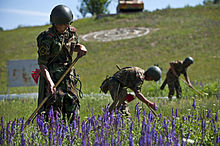
Kyrgyz soldiers conducting mine sweeping exercises.
The armed forces of Kyrgyzstan were formed after the collapse of the Soviet Union and consist of the Land Forces, Air Forces, internal troops, National Guard, and the border guard. The military works with the US Armed Forces, which leased a facility named the Transit Center at Manas at Manas International Airport near Bishkek until June 2014.[59] In recent years, the armed forces have begun developing better relations with Russia including signing modernization deals worth $1.1bn and partaking in more exercises with Russian troops.[60] The Agency of National Security works with the military and serves similar purposes to its Soviet predecessor, the KGB. It oversees an elite counterterrorism special forces unit known as "Alfa", the same name used by other former Soviet countries, including Russia and Uzbekistan. The police are commanded by the Ministry of the Interior Affairs, along with the border guard.
Administrative divisions
Kyrgyzstan is divided into seven regions (sing. oblast (область), pl. oblasttar (областтар)) administered by appointed governors. The capital, Bishkek, and the second largest city Osh are administratively independent cities (shaar) with a status equal to a region.
